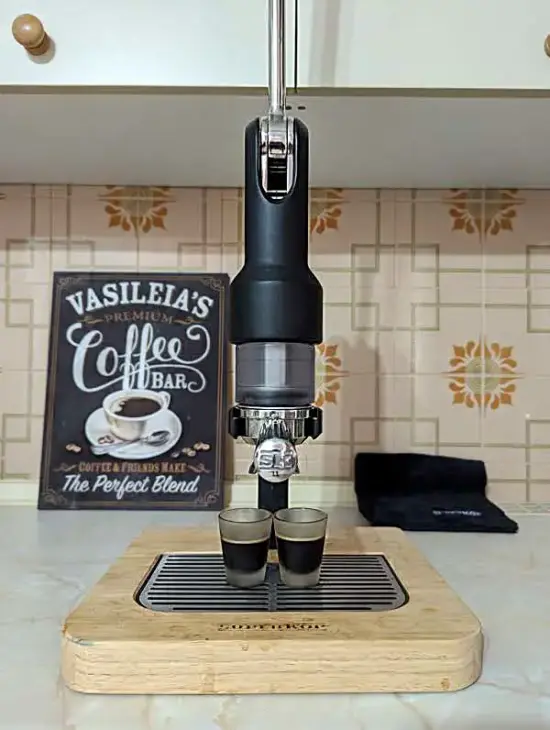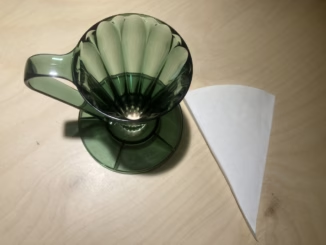
We tried out the Superkop, the durable, non-electrical espresso machine. Here’s what we found!
BY VASILEIA FANARIOTI
SENIOR ONLINE CORRESPONDENT
Photos courtesy of Vasileia Fanarioti & Superkop
Eight years ago, Geert Kaal and Sabine Palinckx set out on a mission: to build the world’s most durable non-electrical espresso machine. The coffee lovers had worn out a number of espresso machines over the years and were inspired to create an appliance that could last for generations and generate less waste. With the help of a team of technical experts, Geert and Sabine worked tirelessly to bring their dream to life. Finally, they reached their goal and the Superkop espresso-making tool was born.
I have been testing the Superkop for a few weeks now, and after much experimentation, I am thrilled to share my experience. In a nutshell, the Superkop delivered everything I had been promised, as well as hoped for, and more.
Design & First Use
Superkop is an innovative espresso-making tool designed for daily use. It operates manually, with no need for electricity or warm-up time. As a countertop accessory, the Superkop looks sleek and modern with its clean, robust design. Additionally, the tool can be wall-mounted.
The Superkop machine weighs approximately 17.6 pounds and is positioned on a wooden base. It is composed of an aluminum-powder-coated outer shell and steel inner components. The lever and portafilter are made of polished SS, and the portafilter has a standard diameter of 58mm. The dedicated water cup is made from polycarbonate material, which was chosen for its ability to hold hot water at temperature without the need for pre-heating.

The first surprise came when I realized that unlike traditional manual espresso machines, the Superkop uses a 1:40 displacement mechanism that applies escalating pressure via a series of six lever pumps. For a double espresso, the manual suggests 18g of ground coffee, 60ml of water heated to 203°F, and a 25–30-second extraction. I followed the recipe and started by adding the coffee in the portafilter, then tamping.
I added hot water into the water cup up to the second marker line (60ml) and pressed onto the basket. Once I inserted this assembly into the body of the Superkop, I began pumping on its lever, slowly and steadily. At this point, the one-way valve allowed a pneumatic spring to bring the lever back up while keeping pressure during each pump. After six pumps, I had made my first double espresso using the Superkop—it was so easy! Finally, I released the piston by pushing the lever toward the back of the device to relieve pressure.

Brewing with the Superkop
Getting the hang of the Superkop was very simple. By following a few straightforward steps, I was able to produce a decent cup of espresso. But the fun had just begun. I went on to experiment with different coffee grind sizes and drink styles to see how the Superkop would perform.
Since it’s summer here in Athens, I decided to try a freddo—or iced and blended—cappuccino. I used my Comandante – C40 MK4 Nitro Blade for grinding and the NanoFoamer V2 by Subminimal to froth the milk. After a few attempts, I found that 13 clicks on the Comandante was my preferred grind size for the Superkop.

The result was excellent. The dense crema layer was a deep dark brown color, and it melted perfectly into the milk foam. I should also note that I did preheat the water cup on several attempts but found that preheating is not necessary with the Superkop—at least not during summer time.
I ended up brewing a number of different drinks with the Superkop, including lattes, flat whites, espressos, and macchiatos, all the while playing with different variables such as grind size, coffee dose, and water temperature. I can confidently say that Superkop’s overall performance was outstanding.

Maintenance, Cleaning, & Add-Ons
To keep the Superkop running smoothly, you need to make sure that all parts are regularly cleaned and maintained. The portafilter can be easily cleaned with hot water and should be completely dried before use. You can also put it in the dishwasher for added convenience. To clean the drip tray and grid, wash them with hot water or run them through the dishwasher.
You’ll need a soft cloth and hot water to clean the water cup. And important to note: The Superkop manual directs the user to never take apart the bottom or put it in the dishwasher. If all these maintenance steps are followed carefully, you will be able to enjoy beautiful espresso from the Superkop every time. Additional accessories include the wall set and a microfiber towel. Extra portafilters, water cups, drip trays, and filter baskets are also available for purchase. In the near future, Superkop expects to release barista tools and accessories, including a tamper, knockbox, and dosing cup.

Superkop is priced at €798,96 incl. VAT (about $800 USD due to lower VAT via NativeDesign/DoubleShotCoffee in Tulsa, Okla.) and comes in three colors: black, white, and red. All versions come with a sustainably harvested rubber-wood board. This is not only aesthetically pleasing, but is a clever nod to sustainability in your espresso experience.
All in all, the Superkop manual espresso-making tool is a great choice for home brewers who want a compact and easy-to-operate machine. Its maintenance is relatively simple, and the machine can make great espresso drinks with just a few pumps of the lever. I really enjoyed the simplicity of the Superkop, and its modern, clean design also adds a definite aesthetic value to any countertop or wall.
Have a look at Superkop’s shop for more information.
ABOUT THE AUTHOR
Vasileia Fanarioti (she/her) is a senior online correspondent for Barista Magazine and a freelance copywriter and editor with a primary focus on the coffee niche. She has also been a volunteer copywriter for the I’M NOT A BARISTA NPO, providing content to help educate people about baristas and their work. You can follow her adventures at thewanderingbean.net.

READ THE LATEST BARISTA MAGAZINE
Out now: It’s the August + September 2023 issue of Barista Magazine, featuring Boram Um of Brazil on the cover. Read it for free with our digital edition. Get your Barista Magazine delivered; start a subscription today! Visit our online store to renew your subscription or order back issues.




